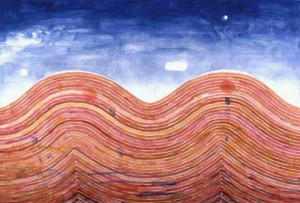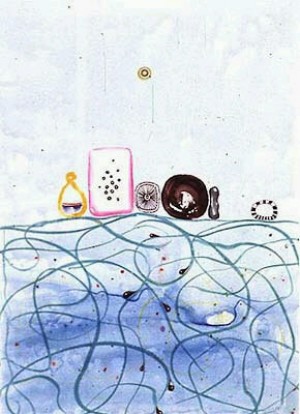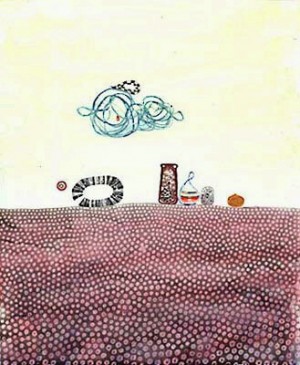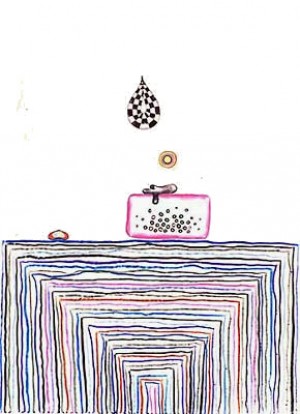Jewish Education for a Time of Wandering
I am a Jewish educator, not a philosopher or an academic, but this is an article about the philosophy of Jewish education. That is, this is an article about the Big Picture. My work with college students over the past decade has led me to believe that if we are not guided by a philosophy of Jewish education—a big picture idea of the aims of education and the best strategies to achieve those aims—much of our day-to-day work is wasted (at best) or counterproductive (at worst).
Education should be driven by a vision that answers these questions:
• Who are the people we wish to see at the end of the educational process?
• What is our understanding of the world that they will inhabit (as opposed to the world as it is today)?
• What effect do we hope they will have on that world (or how do we hope that the world will affect them)?
During stable times, it may not be necessary for educators to enunciate a philosophy of education because the aims and methods of education for a time of stability are implicitly understood, generally agreed upon, and have proven successful over a long time in accomplishing their ends. At such times, a skillful educator can, in principle, achieve the society’s desired results simply by following a tried and true pedagogical methodology without necessarily understanding why that methodology is a good one. Such a teacher does what has always been done, and it works.
But imagine Jewish educators living soon after the failed Bar-Kokhba revolt, perhaps around the year 140, when it became unmistakably clear that the Jewish future would be very, very different from its past. What if these educators had become lost in tragic nostalgia, thinking only of the great treasures of the Second Temple period, clinging desperately to memories of what used to work and educating students accordingly? Thankfully, even if there was some of this, the educators of that time looked mostly to the future. They innovated and created the educational curriculum of the developing yeshivot that facilitated the transition to a very new Judaism. We too are living in a period of uncertainty, of wandering—a transition from one Judaism to another. Analogizing Jewish transitions to major transitions in the technology arena, we might say that we are living during the transition from the Judaism 3.0 series (that is, Rabbinic Judaism) to Judaism 4.0. Rabbinic Judaism replaced Second Temple Judaism (the 2.0 series), which itself replaced the Biblical Judaism (which was, of course, not actually called “Judaism”) that we can think of as the original version 1.0.
We know that the substance of Judaism 4.0 will be very different from what Judaism looked like before, but we do not know yet what it will look like. There is no widespread agreement on the nature of the Jewish community that our young people will enter, nor is there agreement about who we want these young people to be. Will Jewish community continue to be built around the synagogue and prayer? What role will geography play—whether we are talking about geographical proximity as a defining feature of what constitutes a Jewish “community,” or whether we are talking about the role of the Land of Israel in Jews’ lives? Do we want young people to be Hebrew speakers? Activists for social change? Passionate defenders of the Israeli state? Talmud scholars? Authors of a new central text? Parents who keep alive ethnic traditions for their children? Spiritual believers who seek God in daily life? All of the above? None?
When the very nature of Judaism is changing, when we do not agree on our answers to the fundamental questions that drive Jewish education, it is absolutely essential for educators to ground our efforts in a coherent pedagogical philosophy aimed at the process of transition itself. The tried and true educational methods once designed to prepare young people for a commonly agreed upon Jewish adulthood that centered around synagogue life and outsider status, for example, are now anachronistic, dysfunctional, and bound to fail. In a time of transition, educators must re-examine the aims of education and develop new methods to serve new aims.
A Philosophy of Discovery
How do we go about creating an educational philosophy when our community does not agree about—what Judaism will or should look like in the future? In the midst a paradigm shift, the Jewish future’s most pressing need is two-fold: to train some number of individuals to become “discoverers” and to prime everyone else to embrace good ideas as they materialize. That is, instead of attempting to decide what the Jewish future will be, we need educators to embrace the transition itself. We need to develop leaders who can find new paths forward that we cannot imagine today, and we need to foster receptive and engaged citizens who will be eager to explore these new paths.
For the “discoverers,” imagine a school for sea captains during the Age of Discovery. No one knew what the explorers were going to discover; it would have been impossible, for example, to train the sea captains to speak the local dialects of the native people they would meet, as no one had yet met these native peoples. It would have been impossible to teach them about local flora and fauna. So what would have been the aim of education? To instill a yearning to discover new things, to have the sailing skill not to perish at sea, to understand higher level linguistic ideas that would enable them to pick up the native languages more easily, and other topics of that nature.
This is the situation of Judaism today. Of course, the form Judaism 4.0 takes, will not exactly be discovered, but rather created. And this creation will take place in a decentralized fashion, its form dictated to a large extent by what “works” and what doesn’t work, what resonates with people and what doesn’t. Still, in this kind of redesign, there is a bigger element of discovery than one might initially think. Think about the paradigm shift in the field of transportation from horse-drawn carriages to the automobile. The modern automobile was not discovered, but it wasn’t exactly designed either. Many different designers experimented with many different designs; some worked better than others, and some caught on with people better than others. Over time, a new “design language” for automobiles emerged, and so one might say that the forms of modern transportation were thus “discovered.” Another way of saying this is that what people liked and didn’t like, combined with what worked well and less well, constituted the selective pressure or market forces that “discovered” the modern car. In discovering Judaism 4.0, we need designers who have learned to “reverse engineer” the forms of Jewish life that developed in Version 3.0—to understand the deep wisdom, the values, and the spiritual needs that animated the structures and practices of Rabbinic Judaism—and to “re-engineer” new forms that allow this timeless wisdom to be accessible by and relevant to modern Jews.
Imagine, for example, what would happen to the Passover seder if Passover happened to take place in the summer, and Jewish summer camps were thus required to run seders. My guess is that the seder would start to change in profound ways as camp educators (many of whom are outstanding designers of new types of powerful Jewish experiences) came to see that simply eating symbolic foods was not allowing the campers to experience truly the meta-goal of Passover—that “in every generation, a person is required to view himself as if he himself were liberated from Egypt.” Based on developmental and pedagogical ideas, as well as trial and error, counselors might wake the children up at 5:00 am, and supervise them as they groggily and unhappily made bricks out of straw and mud; then, after the bricks dried in the sun while the children ate a bland breakfast, campers would build some sort of cabin out of the bricks; after a long morning of work, they would shower and dress in white and walk in a joyous procession to the dining hall for a sumptuous meal—truly gaining a sense memory of the transition from slavery to freedom. Perhaps the entire camp would then spend the intermediate days of Passover doing public service work in the local community, while conducting intense conversations about how a freed slave must act in the world.
Judaism as Remix
Rabbinic Judaism is essentially a remix of the preceding Temple-centered version (which itself included elements of the previous version, such as an emphasis on the kind of storytelling that dominated pre-Temple Israelite sources) and many elements of Greek thought that had been foreign to Temple Judaism. In their remix, the rabbis reached back to the time of the prophets—emphatically part of Version 1.0—to claim their mantle of authority (the very first sentence of Pirke Avot, which talks about the transmission of the Torah, does not even mention the priests who had ruled over the Jewish people for the previous half millennium). Rabbinic Judaism is full of Greek ideas. Even core Rabbinic terminology—such as pardes, which is derived from the Greek paradeisos, meaning “paradise”—had to be imported in order to express concepts that were themselves imported. Judaism 4.0 will be a remix of elements of Version 3.0, Version 2.0, and Version 1.0, as well as many contemporary ideas and practices from non-Jewish sources. That means education is more important than ever. During this time of paradigm shift, Jewish “deejays” must be well-versed in all three past versions of Judaism, as well as in the potential sources of imports, in order to put together remixes that have a chance of building a new Judaism that is authentically anchored in the past, resonant in the present, and coherent and stable for the future.
I do not claim to know what this remix will produce, but a few examples of remixes already taking place hint at a potential flavor. Take the concept of kashrut, which many contemporary Jews have totally discarded because the halakhic/rabbinic approach does not speak to them. In remixes by groups like Hazon, contemporary concerns about food—sustainability, environmental damage, treatment of food workers—are being pulled into the older Jewish concept. In Judaism 4.0, keeping kosher may have less to do with preserving an ancient technology of slaughter, mixing milk and meat, or other specific interpretations and regulations imposed in the past by rabbinic authority, and much more to do with a developing social norm of eating one’s values, these values having been derived from Jewish sources and that strongly resonate with contemporary Jews, such as concern for the earth and for the needy and the oppressed, as well as for the treatment of other living creatures. It is not hard to imagine this new definition of kashrut attracting more followers than the current definition.
As more and more of Judaism is remixed, its most significant essences (in this case, the idea of eating norms that reflect a recognition that eating is an activity that carries moral responsibilities), individuals and communities will be able to stitch these together into coherent, and stable systems for living a rich Jewish life that have the power of attraction.
A Methodology for Discovery
If our objective is to educate Jewish discoverers and to cultivate a Jewish citizenry open to their discoveries, how do our methods of education have to change to achieve these objectives?
First, and perhaps most difficult to swallow, is that rather than being socialized into the system, people with leadership qualities should be encouraged to see its faults. We cannot discover the new if we are chained to the old. At the same time, leaders must understand what it is they are leaving behind and love the tradition enough—or at least enough of it—to want to fix it.
For leaders to be able to redesign Judaism they must have a deep understanding of what Judaism has been, as well as the capacity to develop a vision of what it (or at least parts of it, as not every leader needs to see the full picture) might become in the future. Education cannot be simply a matter of design skills and entrepreneurship. While we want them to make profound changes, we must also insist that our future leaders immerse themselves in everything that has come before. As a leading Jewish educator recently told me, “Scientists have discovered that amnesiacs cannot dream.” And how can a person write the eleventh chapter in a book, he asked, if they haven’t read the first ten?
The discoverers we need to guide the transition to Judaism 4.0 must love Judaism (Jewish summer camps are a highly functional approach to inspiring leaders in this regard), learn history (particularly in a way that emphasizes how Judaism has changed profoundly over time), and master a process of redesign (design schools don’t tell students what to make, but rather teach them principles that they can use to design anything; likewise here).
Potential leaders need to understand the history of Jewish paradigm shifts. For them to become part of Version 4.0—either as leaders or as engaged Jewish citizens—they need to understand that Judaism has never been static during times of upheaval and that it has successfully changed in profound ways before, eliminated core elements from the previous version (and assigned them to the realm of the messianic age) and adopted as core elements that would have been viewed as totally foreign a few decades earlier.
There will be individuals who, like Rabbi Akiba in the previous transition, did not grow up in families strongly identified with the structures and ideals of the current version. These potential Jewish leaders also must learn the history of change within Judaism, because most of them also have absorbed the myth that “authentic” Judaism remains unchanged. More than their more knowledgeable peers, however, they also will need to spend time becoming immersed in the building blocks of Versions 1.0, 2.0, and 3.0 so that they can acquire the raw materials to remix and the ability to judge what from the past is valuable for the future and what seems less relevant. In both cases, there is a big difference between teaching about what Judaism has been with the goal of encouraging people to embrace what Judaism is today, which seems to be the driving force behind much of contemporary Jewish education, and teaching about the Jewish past and present as a toolbox for designing a radically different future.
Over the past two decades, a variety of “pluralistic” or “secular” yeshivot and batei midrash (houses of study) have come into existence in Israel. These include Elul, Oranim, Alma, and Bina, to name the most prominent. At these institutions, Jews who define themselves as “secular” or “non-religious,” as well as some who define themselves as religious, study Jewish texts, Jewish history, and Jewish thought in an immersive and serious way, just as religious Jews do in religious yeshivot, but without ideological preconditions or lenses and with true openness to any interpretation or implication. Immersion in Jewish sources without a commitment to existing forms of Jewish living is exactly the sort of education that Jewish discoverers need, and indeed much of the experimentation going on today in Israel in the “secular space” is led by people who have studied at these institutions. We need such batei midrash in the United States, and we do not have them. The curriculum of an American “secular yeshiva”—a new type of institution to train pathfinding leaders—should include Jewish texts and history, as well as training in creativity, innovation, execution, experimentation, impact assessment, and other relevant skills. The future of a remixed Judaism 4.0 requires first a remix of Jewish educational institutions. Imagine a traditional yeshiva crossed with both a design school and a Jewish Studies department, and a vision of what this might look like starts to form.
In addition to new institutions, existing ones may also provide valuable contexts for this kind of remix education. For example, the spirit of the American university—where Hillels are housed—is a spirit of serious inquiry about the past and creativity for the future, scholarship and originality, which is consistent with such an approach. A “pluralistic yeshiva” or less intensive education programs could find an audience in this age cohort, as might two or three-year work-study programs. Teach for America demonstrates that young adults are willing, and even eager, to spend a few years after college working in a field that will not necessarily be their ultimate career destination; and if they have a good experience, they might stay for life.
One might ask whether targeting paradigm-shift education at this group does not come too late. Perhaps these young Jewish adults are so turned off by Judaism that they would not give it a chance? This has not been my experience, and studies of young people in their twenties suggest that they are especially open to trying new things. Our experience on campus is that with good marketing and endorsements from trusted peers (which we can only get by delivering a great product), it is possible to attract young adults to educational opportunities and that they are intrigued by an approach that encourages them to work to change what they don’t like rather than simply abandon it.
Conclusion
In the modern world, time feels sped up, and we are more impatient than ever to find immediate answers and to get where we are going. We all want to know what the future of Judaism will be, and we want to know it now. Paradigm shifts, however, take their own time. Previous versions of Judaism did not appear overnight, but rather took hundreds of years to materialize and solidify. Even after the cataclysm of the destruction of the Second Temple, the Jewish people wandered in the theological wilderness for at least another century before the consolidation of Rabbinic Judaism.
While we may be closer to the end than to the beginning of the paradigm shift that began 300 years ago with the Enlightenment and the Emancipation, we must acknowledge that we still live in a time of instability and transition—a time of wandering—and must educate accordingly.
An education of not knowing, an education of discovery, is our best hope.
![[the current issue of ZEEK]](../../image/2/100/0/5/uploads/leftistethicistgraphic-52842c6a.png)
- 5000 Pages of Zeek
- Founded in 2001, Zeek was the first Jewish online magazine, and we have over 5000 pages online to prove it, all available free of charge. Read more in the Archive.
More articles in
Life and Action
- Purim’s Power: Despite the Consequences –The Jewish Push for LGBT Rights, Part 3
- Love Sustains: How My Everyday Practices Make My Everyday Activism Possible
- Ten Things You Should Know About ZEEK & Why We Need You Now
- A ZEEK Hanukkah Roundup: Act, Fry, Give, Sing, Laugh, Reflect, Plan Your Power, Read
- Call for Submissions! Write about Resistance!





